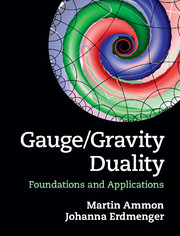Book contents
- Frontmatter
- Contents
- Preface
- Acknowledgements
- Part I Prerequisites
- Part II Gauge/Gravity Duality
- 5 The AdS/CFT correspondence
- 6 Tests of the AdS/CFT correspondence
- 7 Integrability and scattering amplitudes
- 8 Further examples of the AdS/CFT correspondence
- 9 Holographic renormalisation group flows
- 10 Duality with D-branes in supergravity
- 11 Finite temperature and density
- Part III Applications
- Appendix A Grassmann numbers
- Appendix B Lie algebras and superalgebras
- Appendix C Conventions
- Index
- References
7 - Integrability and scattering amplitudes
from Part II - Gauge/Gravity Duality
Published online by Cambridge University Press: 05 May 2015
- Frontmatter
- Contents
- Preface
- Acknowledgements
- Part I Prerequisites
- Part II Gauge/Gravity Duality
- 5 The AdS/CFT correspondence
- 6 Tests of the AdS/CFT correspondence
- 7 Integrability and scattering amplitudes
- 8 Further examples of the AdS/CFT correspondence
- 9 Holographic renormalisation group flows
- 10 Duality with D-branes in supergravity
- 11 Finite temperature and density
- Part III Applications
- Appendix A Grassmann numbers
- Appendix B Lie algebras and superalgebras
- Appendix C Conventions
- Index
- References
Summary
Solving interacting quantum (field) theories exactly for all values of the coupling constant, and not just for very small coupling constant where perturbation theory is applicable, is a long-standing open problem of theoretical physics. By exactly solving we mean diagonalising the corresponding Hamiltonian, such that both eigenstates and eigenvalues are known explicitly. This is an extraordinarily difficult task: for instance, for QCD this would mean finding the complete mass spectrum from first principles from the QCD Lagrangian using analytical methods, as well as the associated eigenstates. This is certainly impossible at present for such a complicated theory.
The same problem occurs also for quantum mechanics. For most quantum systems, the complete set of eigenstates is not known. However, within quantum mechanics there are some cases where an exact solution is possible: the harmonic oscillator and the hydrogen atom, for instance. These systems should be viewed as toy models since they are ideal approximations to systems realised in nature. For instance, to describe real oscillators in solids, higher order interaction terms have to be added.
In quantum field theory there are also exactly solvable toy models: however, they are defined in low spacetime dimensions, for instance in d = 1 + 1. An example is the Thirring model which is integrable in the sense that it has an infinite number of conserved quantities. Are there any interacting exactly solvable quantum field theories also in 3+1 dimensions? The surprising answer is yes: there is a large amount of evidence that N = 4 Super Yang– Mills theory has an integrable structure, at least in the planar (large N) limit. The evidence for such an integrable structure at strong coupling has been found using the AdS/CFT correspondence. Since N = 4 Super Yang–Mills is a conformal field theory, in the planar limit the theory is characterised completely by the scaling dimensions Δ of the composite local operators built from products of elementary fields.
- Type
- Chapter
- Information
- Gauge/Gravity DualityFoundations and Applications, pp. 240 - 272Publisher: Cambridge University PressPrint publication year: 2015

